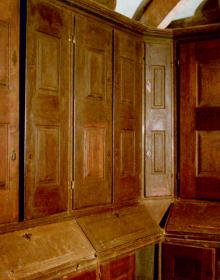- HOME
- MONUMENT
- Convent of Christ
- History
- Architecture
- Personalities
- King Afonso Henriques
- D. Gualdim Pais
- King Dinis
- King John I
- D. Lopo Dias de Sousa
- King Duarte
- Prince D. Henrique (Henry
- King John II (1455 - 1495
- King Manuel I (1469 - 152
- Diogo de Arruda
- João de Castilho
- Jorge Afonso
- Olivier de Gand
- King John III (1502 - 155
- Diogo de Torralva
- Friar Anthony of Lisbon
- Baltazar de Faria
- Filipe Terzi
- Philippine Dinasty
- King Philip II of Spain
- King John IV
- Domingos Serrão
- Queen Mary II
- Prince Fernando
- Costa Cabral
- Artisans and Artists
- Intangible Heritage
- Related Heritage
- Glossary
- VISIT OUR MONUMENT
- HERITAGE LEARNING
- TOMAR
- MONASTERIES ROUTE

RESEARCH PROJECTS
1 - The Portuguese territory
1.1 - The first land donations and their historic context
2 - The territorial organisation of the Knights Templar
2.1 - The insignia
2.2 - The churches
2.3 - The castles
3 - The evolution of the Templar legacy
4 - The memory of the Knights Templar in Portuguese territory
Tomar
1 - The Termo de Ceras lands and the historic background to their donation to the Knights Templar
2 - Templar sites neighbouring on Termo de Ceras lands
3 - The Tomar region. Geography and historic landscape
4 - The territorial organisation of the Knights Templar in Tomar
5 - The Templar architecture in Tomar
6 - The evolution of the Tomar region
6.1 - Historical evolution
6.2 - The evolution of the landscape:
a) urban
b) rural
6.3 - Socio-cultural evolution
7 - Memory of the Templars and social everyday life in the Tomar region
The TACELO Research Project
The TACELO project was submitted to the Science and Technology Foundation (FCT) for subsidies and support.
It is a research project whose main aim is improving the technical knowledge (materials, execution and alteration techniques) and testing methodologies and products that are appropriate for the conservation and restoration of the monumental terracotta sculptures at the Monastery of Alcobaça. The project focuses in particular on the sculptures in the high altar, proposing pilot treatment for the Annunciation group (of two sculptures) and other pieces to be selected that are in urgent need of intervention. The whole study project will be supported by laboratorial examinations and analyses by acknowledged specialists with many years of practice.
The institute that has submitted the project is Tomar Polytechnic and participating institutions are the University of Lisbon Foundation, IGESPAR, the Institute of Museums and Conservation, the New University of Lisbon, GEOBIOTEC Investigation Unit and, as the additional investigation unit, the Atomic Physics Centre of the University of Lisbon. The host institution is Tomar Polytechnic.
As is normal in projects of this kind, it is hoped that the research will advance the knowledge on sculptures in terms of their degradation and conservation.
The team is aware that, notwithstanding the discovery of new and valid data, the conservation and restoration of the more deteriorated and altered sculptures will always be a highly complex and risky long-term operation.
IGESPAR will be responsible for providing transport for the pieces to the Institute of Museums/Ministry of Culture or other laboratories and will be particularly involved in the museographic project for presentation of the high altar sculptures and in the conception of a didactic project for the virtual reconstruction of the high altar as it existed before the DGEMN intervention in the 1940s.
SERVICES - ACTIVITIES



